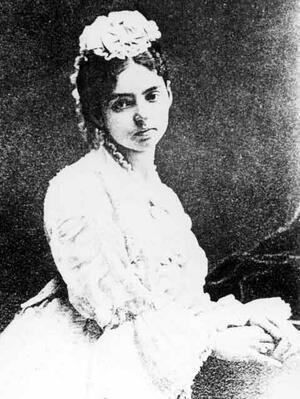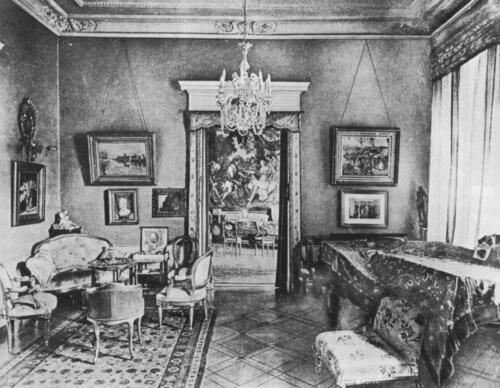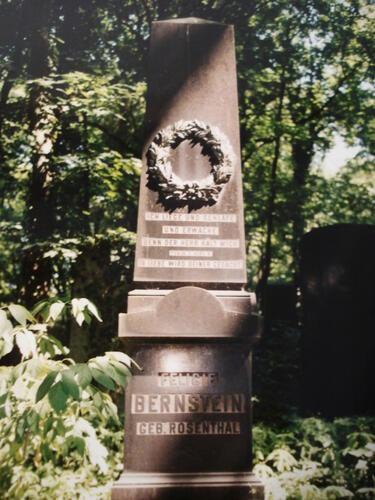Felicie Bernstein
Felicie Rosenthal, born in St. Petersburg, married the scholar of Roman Law Carl Bernstein in Vienna. They settled in Berlin, where Carl Bernstein taught at the university and they had an international literary salon. In 1882, they bought impressionist paintings in Paris and brought them to Berlin. At first the paintings met with incomprehension, but they later gave valuable impulses to young artists and open-minded museum directors. After her husband’s death in 1894, Felicie Bernstein continued her salon and art patronage. She became interested in social reform and feminism and assisted projects for artists and philanthropic causes. Before her death, she bequeathed a considerable legacy to the Berlin Secession and left valuable objets d’art and paintings to her friends and to museums in Berlin.
Felicie Bernstein was one of the last Berlin salonnières, a patron of modern art and artists, and a philanthropist who supported early feminism.
A Salon in Imperial Berlin
Felicie Bernstein, née Rosenthal, was born on September 7, 1850, in St. Petersburg (although different dates are sometimes given in secondary sources). The daughter of a wealthy St. Petersburg commercial businessman, Leo Rosenthal (d. c. 1890), she lost her mother at an early age. After being educated at a private school in Dresden she returned to St. Petersburg, where she exercised her social talents at the hospitable house of her father and fell in love with the lawyer and brilliant scholar Carl Bernstein (1842–1894) from Odessa. She married him in Vienna on January 14, 1872.
Though Leo Rosenthal wished the couple to live in Russia, this was impossible, because at that time Jews were excluded from university careers there. Since Carl Bernstein had studied in Germany (Ph.D. Berlin 1864), he moved to Berlin in 1873 with his wife, his stepmother Emilie (1821–1891), and his sister Thérèse (1850– 1902). In 1878 Carl Bernstein became private lecturer and in 1886 professor for Roman Law at the University of Berlin.
In their splendid flat in the Tiergarten (In den Zelten 23), where they lived in the 1880s, the Bernsteins received numerous interesting and international guests, among them university professors, writers, musicians, painters, and art historians. A tiny and vivacious woman, Felicie Bernstein had considerable social talents as well as a great deal of esprit, sparkling wit, and spontaneous humour. She combined cleverness with instinctive goodness of heart. In her salon she was assisted by her sister-in-law Thérèse, who had an amiable but serious character. Thérèse was the précieuse of the family, very fastidious in points of decorum and politeness, and gave absent-minded professors discreet hints when anything was amiss with their attire. Wednesday, the jour fixe, developed into one of the last culturally influential salons in Berlin. The flat was elegantly furnished, mainly Louis-Seize, adorned by good old and modern paintings, tapestries, and objets d’art. Special sanctuaries were Carl Bernstein’s library (with a fine collection of first editions, e.g. of Goethe’s works) and the Bernstein ladies’ little oriental sitting room.
Distinguished Guests and Friends
Old friends of the family were the law scholar Rudolph von Gneist (1816–1895) and the archaeologist Georg Treu (1843–1921), director of the collection of sculptures at the Albertinum in Dresden (a distinguished museum named after King Albert of Saxony). Among the guests were the historian Theodor Mommsen (1817–1903); the historian and archaeologist Ernst Curtius (1814–1896); the sculptor Louis Tuaillon (1862–1919); and the painters and graphic artists Max Klinger (1857–1920), Paul Meyerheim (1842–1915), Adolph von Menzel (1815–1905), Walter Leistikow (1865–1908), and Sabine Lepsius (1864–1942), who had a salon herself at the turn of the century.
Other visitors included open-minded museum directors, namely Wilhelm Bode (1845–1929), Hugo von Tschudi (1851–1911), and Alfred Lichtwark (1852–1914). Literature was represented by Karl Emil Franzos (1848–1904), the Dane Georg Brandes (1842–1927), and the French poet Jules Laforgue (1860–1887); music by the famous singers Francisco d’Andrade (1859–1921), Désirée Artôt-de Padilla (1835–1907), and Anna Schultzen-von Asten (1848–1903), the composer and violin virtuoso Joseph Joachim (1831–1907) and Richard Strauß (1864–1949). Probably around 1905, the industrialist and politician Walther Rathenau (1867–1922) and his brilliant sister Edith Andreae (1883–1952) joined the circle. One of Bernstein’s most faithful habitués since 1885/86 was the painter Max Liebermann (1847–1935), who later described it as a reincarnation of the salon of Henriette Herz.
Pioneers of Impressionism and Modern Art
The Bernsteins cultivated far-reaching interests in European history, literature, and art, but their special love was for the eighteenth century. The shades of light and color in Rococo paintings may have prepared the ground for their appreciation of French impressionism. Carl Bernstein’s cousin Charles Ephrussi (1849–1905) was director of the Gazette des Beaux-Arts in Paris, an expert on Renaissance art as well as an early champion of impressionism. An even more ardent admirer of the new style was Ephrussi’s former secretary, the young poet Jules Laforgue (1860–1887), who lived in Berlin from 1881 to 1886 as French reader of the Empress Augusta. Beginning in January 1882, he visited the Bernstein family and may have passed on his enthusiasm. In any case, in the summer of the same year the Bernsteins bought paintings by Manet, Monet, Pissarro, Berthe Morisot, and others in Paris, which were a much-discussed novelty in Berlin. The young painter Max Klinger was enraptured, but eccentric old Adolph Menzel did not appreciate them and asked the hostess, according to Max Liebermann’s famous version of the story, whether she had actually paid money for that trash. Felicie Bernstein told the story herself in 1907 along the same lines, but without the most drastic expressions; when his companion Paul Meyerheim had urged Menzel to soften his harsh comments, the latter readily agreed and said: “Madam, I am sorry to have uttered such hard remarks about your beloved paintings. But it is my firm conviction.”
In late 1883, the exhibition of the Bernsteins’ paintings at Fritz Gurlitt’s art gallery caused controversies but was a landmark for modern art in Berlin. Discussions in the Bernstein salon led to efforts that later brought about the founding of the Berlin Secession (1898), which became a platform of modern art in Berlin—in opposition to Emperor William II, his taste, and his politics in art. Shortly after the opening of the Secession’s first exposition in 1899, Felicie Bernstein gave a dinner party in honor of the occasion.
Salon and Art Patronage After Carl Bernstein's Death
After the lingering illness and death of Emilie Bernstein in 1891, Carl Bernstein’s heart disease and deteriorating eyesight forced him to retire. The family left its flat and travelled in order to restore his health. In 1892 their musically gifted young friend (and almost foster-daughter) Johanna von Rentzell, who had lived with the Bernsteins since the mid-1880s, married Andreas von Tuhr, a professor of law in Basel and later in Straßburg.
When the Bernsteins returned to Berlin, they lived in the Hotel Kaiserhof. In 1894, before they had found a new flat, Carl Bernstein died when a small infected wound developed into sepsis. His widow bequeathed his beautiful collection of illustrated eighteenth-century French classics to the Berliner Kupferstichkabinett (graphics collection) under the care of its director Friedrich Lippmann (1838–1903), who was a close friend. She also helped to promote impressionism in Germany by lending several of her paintings to Lichtwark for an exhibition at the Hamburger Kunsthalle (1895).
In 1896 Felicie Bernstein and her sister-in-law moved into a flat at Stülerstraße 6, where they continued their salon on a smaller scale. Felicie Bernstein still bought paintings, including a Manet and several works of the Goppelner Malerschule (a painter’s colony near Dresden), some of which were by women. More conventionally, she also collected miniature Dresden china, old Berlin porcelain cups, and painted fans (some fans were shown at an exhibition in 1905). A special protégé was the talented but consumptive modern sculptor August Hudler (1868–1905).
In 1898 and 1899 Felicie and Thérèse travelled to Britain, and in 1900 they visited the World Exhibition in Paris. Wherever they stayed, their hotel suites became temporary salons and they made friends with many interesting figures, among them the novelist Emile Zola (1840–1902). Felicie Bernstein also remained close to her husband’s relatives, especially with the Ephrussi brothers and the scholar Théodore Reinach (1860–1928), whom she visited in Paris and in Switzerland. The younger generation now venerated impressionism. In January 1902, the writer and art connoisseur Harry Count Kessler (1868–1937) met the Bernstein ladies (qualifying them as “Manetbesitzerinnen,” or “owners of paintings by Manet”) at a dinner-party given by Hugo von Tschudi. Kessler’s diary shows that he had no idea about the rôle they had played two decades earlier. Felicie told him that when her husband had bought the first Manets, people had explained it by his short-sightedness. She added that only Max Klinger had immediately shown real understanding.
Interest in Feminism and Social Reform, and Legacy
As a widow, Felicie Bernstein developed a keen interest in the social question, the feminist movement, and women’s education. She generously assisted social reform projects and charities and was awarded a medal (“Silbernes Frauen-Verdienstkreuz,” or Silver Cross of Merit for Women), accompanied by a congratulatory letter from Empress Auguste Viktoria. The death of Thérèse Bernstein in 1902, other family sorrows, and her own failing health (she had a cancer operation in 1905) put her under heavy strain, but she did not lose heart. She still presided at her “Wednesdays,” and even gave dinners for a more intimate circle and arranged private Sunday concerts for the benefit of young artists. Among her good friends was the salonnière Emma Dohme (1854–1918), widow of the art historian Robert Dohme (1845–1893), who accompanied her on some journeys. In 1907, Felicie Bernstein gave a generous donation to the “Villa Romana,” which provided workshops for German artists in Florence. She had always loved Italy.
Not only a brilliant storyteller but also a gifted letter writer, Felicie Bernstein always delighted her friends with her clever and amusing observations. Even postcards from her travels inimitably put things in a nutshell. Her last journeys were to places of beauty that helped her to forget her pains: Rome, Weimar, Switzerland, and Dresden.
In 1908, Felicie Bernstein put her affairs in order and took leave of her friends, who were given keepsakes from among her objets d’art or paintings. Max Liebermann received a famous “Champ de coquelicots” by Monet, the Berlin National Gallery Manet’s “White Lilac,” another museum was given a van Goyen. Generous legacies went to the Berlin Secession, to charitable institutions, and others. Her readiness to help others and her love for the good and the beautiful never left her.
Felicie Bernstein died in Berlin on June 11, 1908, and was buried on June 14 at the Weißensee cemetery. The dramatist and novelist Georg Reicke (1863–1923), Second Mayor of Berlin, declared that her salon could never be replaced. Max Liebermann observed that Berlin cultural life had been reflected in her salon for a quarter of a century. He praised her perfectly performed rôle in society: “good and wise, discreet and yet reigning over her circle.” As patrons of art, Carl and Felicie Bernstein have in recent years gradually received the scholarly attention and recognition they deserve.
Primary Sources
Archives of the Jewish Cemetery Berlin-Weißensee / Funeral register: Birth and death records of the Bernstein family. With grateful thanks for gracious assistance to Fiona Laudamus, Förderverein Jüdischer Friedhof Berlin-Weißensee e.V.
[Bernstein, Carl and Felicie.] Carl und Felicie Bernstein. Erinnerungen ihrer Freunde. (Carl and Felicie Bernstein. Recollections of their Friends). Ed. and preface by Georg Treu. With essays by Max Liebermann, Gustav Cohn, Hugo von Tschudi et al. Dresden: Buchdruckerei der Wilhelm und Bertha v. Baensch Stiftung, 1914.
Brandes, Georg. “Japanische und impressionistische Kunst. 30. Oktober 1882.” (“Japanese and Impressionistic Art. October 30th, 1882.”) In Berlin als deutsche Reichshauptstadt. Erinnerungen aus den Jahren 1877–1883. Translated from the Danish by Peter Urban-Halle, ed. by Erik M. Christensen and Hans-Dietrich Loock, 551–560.) Berlin: Colloquium-Verlag, 1989. (Wissenschaft und Stadt. Publikationen aus Anlaß der 750-Jahr-Feier Berlins, vol. 12) [Original: Berlin som tysk rigshovedstad. Kjøbenhavn: 1885.] )
Furtwängler, Adolf. Briefe aus dem Bonner Privatdozentenjahr 1879/80 und seiner Tätigkeit an den Berliner Museen 1880–1894. (Letters from his Year as a Private Lecturer in Bonn and his time as an Assistant at the Museums in Berlin, 1880–1894.) Ed. by Adolf Greifenhagen. Stuttgart, Berlin, Cologne, Mainz: Kohlhammer, 1965.
Kessler, Harry Graf. “Tagebucheintrag, Berlin, 29. Januar 1902.” (“Diary, Berlin, January 29th, 1902.”) In Das Tagebuch, vol. 3: 1897–1905, ed. Carina Schäfer, Gabriele Biedermann [...], 455–456. Stuttgart: Cotta, 2004. (Veröffentlichungen der Deutschen Schillergesellschaft: Harry Graf Kessler. Das Tagebuch, 1880–1937, ed. Roland S. Kamzelak, Ulrich Ott [...], vol. 50.3.)
Klinger, Max. “Kunststreifereien in Paris [1883].” (“Art-Promenades in Paris [1883].”) In Gedanken und Bilder. Aus der Werkstatt des werdenden Meisters, ed. Hildegard Heyne, 26–31. Leipzig: Koehler and Amelang, 1925.
Klinger, Max. Mir tanzt Florenz auch im Kopfe rum. Die Villa Romana in den Briefen von Max Klinger an den Verleger Georg Hirzel. (Florence is dancing in my mind as well. The Villa Romana in the Letters of Max Klinger directed to his Publisher Georg Hirzel.) Ed. and introduced by Angela Windholz. München: Deutscher Kunstverlag, 2005.
Laforgue, Jules. Oeuvres Complètes, vol. IV and V: Lettres, vol. 1 (1881–1882) and vol. 2 (1883–1887). Introduction and notes by G. Jean-Aubry. Paris: Mercure de France, 1925.
Lepsius, Sabine. “Über das Aussterben der ‘Salons.’” (“Reflections about the Vanishing of the ‘Salons.’”) März. Eine Wochenschrift, seventh year, vol. 3 (1913), 222–234.
Lepsius, Sabine. Ein Berliner Künstlerleben um die Jahrhundertwende. Erinnerungen. (My Life as a Berlin Artist at the Turn of the Century. Recollections.) Ed. by Monica Behrendt. Munich: G. Müller, 1972.
Lichtwark, Alfred. “An die Commission für die Verwaltung der Hamburger Kunsthalle, Berlin, February 21st, 1907.” (“Letter to the Commission for the Administration of the Hamburg Museum of Art, Berlin, February 21st, 1907.”) In Briefe an die Commission für die Verwaltung der Hamburger Kunsthalle, ed. by Gustav Pauli, vol. 2, 181–184. Hamburg: Lütcke & Wulff, 1924.
Liebermann, Max. “Meine Erinnerungen an die Familie Bernstein (1908).” (“My Recollections of the Bernstein Family (1908).”) In Gesammelte Schriften, 121–131. Berlin: Cassirer, 1922. Reprint from Carl und Felicie Bernstein. Erinnerungen ihrer Freunde.
Liebermann, Max. Briefe. (Letters.) Ed. Ernst Braun, vol. 1–5, Baden-Baden: Max-Liebermann-Gesellschaft, 2011–2015. (Schriftenreihe der Max-Liebermann-Gesellschaft Berlin e.V., ed. Martin Faass, vol. 1–5)
Rathenau, Walther. Briefe. (Letters.) Vol. 1: 1871–1913. Ed. by Alexander Jaser, Clemens Picht and Ernst Schulin. Düsseldorf: Bundesarchiv Koblenz, 2006. (Walther Rathenau-Gesamtausgabe, ed. for the Walther Rathenau Gesellschaft by Hans Dieter Hellig and Ernst Schulin, for the Bundesarchiv by Tilman Koops, vol. 5.1)
Weisbach, Werner. Und alles ist zerstoben. Erinnerungen aus der Jahrhundertwende. (And All is Gone with the Wind. Recollections of the Turn of the Century.) Vienna, Leipzig, Zürich: Herbert Reichner Verlag, 1937.
Secondary Sources
Augustin, Anna-Carolin, and Anna-Dorothea Ludewig. “Kunst und Leben. Die Sammlerinnen Felicie Bernstein und Margarete Oppenheim.” (“Art and Life. The collectors Felicie Bernstein and Margarete Oppenheim.”) In Elke-Vera Kotowski, ed., Salondamen und Frauenzimmer. Selbstemanzipation deutsch-jüdischer Frauen in zwei Jahrhunderten, 66–88. Berlin, München, Boston: De Gruyter, 2016.
Dollinger, Petra. “Die jüdische Salontradition in Berlin. Vom späten 18. Jahrhundert bis zum Ersten Weltkrieg.” (“The Jewish Salon Tradition in Berlin. From Late 18th Century to World War I.”) In Mitteldeutsches Jahrbuch für Kultur und Geschichte, ed. for the Stiftung Mitteldeutscher Kulturrat by Christof Römer, vol. 8, 75–102. Köln, Weimar, Wien: Böhlau Verlag, 2001.
Dorgerloh, Annette. Das Künstlerehepaar Lepsius. Zur Berliner Porträtmalerei um 1900. (The Artist’s Couple Lepsius. Berlin Portrait Painting around 1900.) Berlin: Akademie-Verlag, 2003.
Grodzinski, Veronica. “Wilhelm II., Hugo von Tschudi and Jewish Patronage of French Modern Art.” In Jüdische Sammler und ihr Beitrag zur Kultur der Moderne / Jewish Collectors and Their Contribution to Modern Culture, ed. Annette Weber, in collaboration with Jihan Radjal-Ordoubadi, 119–132. Heidelberg: Universitätsverlag Winter, 2011.
Junge-Gent, Henrike. Alfred Lichtwark: Zwischen den Zeiten. (Alfred Lichtwark: Between the Times.) München: Deutscher Kunstverlag, 2012. (Forschungen zur Geschichte der Hamburger Kunsthalle, ed. by the Hamburger Kunsthalle and the Hermann Reemtsma Stiftung, vol. 3.)
Knoll, Kordelia, ed. Das Albertinum vor 100 Jahren – die Skulpturensammlung Georg Treus. Zur Erinnerung an die Sammlung der Originalbildwerke am 22. Dezember 1894. (The Albertinum a Hundred Years ago – The Collection of Sculptures under the Care of Georg Treu […]) Exhibition catalogue Dresden 1994/95. Dresden: Staatliche Kunstsammlungen,1994.
Kuhrau, Sven. Der Kunstsammler im Kaiserreich. Kunst und Repräsentation in der Berliner Privatsammlerkultur. (Collectors of Art in Imperial Germany. Art and Representation in the Circles of Private Collectors.) Kiel: Ludwig, 2005.
Ludewig, Anna-Dorothea. “‘Haben Sie wirklich Geld für diesen Dreck gegeben?’ Die Sammlung Carl und Felicie Bernstein.” (“‘Have you Really Paid Money for this Trash?’ The Carl und Felicie Bernstein Collection.”) In Aufbruch in die Moderne. Sammler, Mäzene und Kunsthändler in Berlin 1880–1933, ed. by Anna-Dorothea Ludewig, Julius H. Schoeps und Ines Sonder, 90–103. Köln: DuMont Buchverlag GmbH, 2012.
Paul, Barbara. “Drei Sammlungen französischer impressionistischer Kunst im kaiserlichen Berlin – Bernstein, Liebermann, Arnhold.” (“Three Collections of French Impressionistic Art in Imperial Berlin – Bernstein, Liebermann, Arnhold.”) Zeitschrift des Deutschen Vereins für Kunstwissenschaft, vol. 42, part 3 (1988): 11–30.
Wilhelmy, Petra. Der Berliner Salon im 19. Jahrhundert (1780–1914). (The Nineteenth Century Salon in Berlin (1780–1914).) Berlin, New York: De Gruyter, 1989.
Wilhelmy-Dollinger, Petra. Die Berliner Salons. Mit historisch-literarischen Spaziergängen. (The Salons in Berlin. With Historical and Literary Promenades.) Berlin, New York: De Gruyter, 2000.






